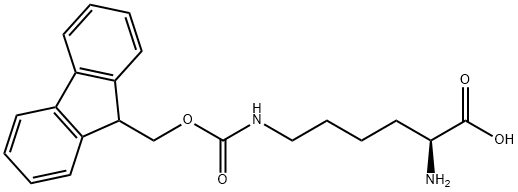N'-Fmoc-L-lysine

|
- ₹0
- Product name: N'-Fmoc-L-lysine
- CAS: 84624-28-2
- MF: C21H24N2O4
- MW: 368.43
- EINECS:
- MDL Number:MFCD00038365
- Synonyms:LYSINE(FMOC)-OH;H-LYS(FMOC)-OH;N-EPSILON-(9-FLUORENYLMETHOXYCARBONYL)-L-LYSINE;N-EPSILON-FMOC-L-LYSINE;N'-(9-Fluorenylmethyloxycarbonyl)-L-lysine;N6-[(9H-Fluoren-9-ylmethoxy)carbonyl]-L-lysine;N'-Fmoc-L-lysine;H-L-Lys(Fmoc)-OH
| Manufacturer | Product number | Product description | Packaging | Price | Updated | Buy |
|---|
Properties
Melting point :209-210 °C
Boiling point :609.9±55.0 °C(Predicted)
Density :1.245
storage temp. :Keep in dark place,Sealed in dry,2-8°C
solubility :Soluble in Chloroform,Dichloromethane,Ethyl Acetate,DMSO,Acetone,etc.
form :Powder
pka :2.53±0.24(Predicted)
color :White to off-white
CAS DataBase Reference :84624-28-2(CAS DataBase Reference)
Boiling point :609.9±55.0 °C(Predicted)
Density :1.245
storage temp. :Keep in dark place,Sealed in dry,2-8°C
solubility :Soluble in Chloroform,Dichloromethane,Ethyl Acetate,DMSO,Acetone,etc.
form :Powder
pka :2.53±0.24(Predicted)
color :White to off-white
CAS DataBase Reference :84624-28-2(CAS DataBase Reference)
Safety Information
| Symbol(GHS): |

|
||||||||||||||||||||||||||||
|---|---|---|---|---|---|---|---|---|---|---|---|---|---|---|---|---|---|---|---|---|---|---|---|---|---|---|---|---|---|
| Signal word: | Warning | ||||||||||||||||||||||||||||
| Hazard statements: |
|
||||||||||||||||||||||||||||
| Precautionary statements: |
|
Description
Nε-Fmoc-L-lysine is an N-Fmoc-protected form of L-Lysine (L468895). L-Lysine is an essential amino acid for humans, with a suggested intake of 5-8 grams per day. L-Lysine can be found in a variety of food, such as eggs and quinoa, but is also mass produced by microbial fermentation. L-Lysine is also used as therapy to treat recurrent herpes simplex infections.Related product price
- FMOC-L-Phenylalanine
₹520-43906.2 - 82911-69-1
₹790-384350 - PYRAZOPHOS
₹7306.88






